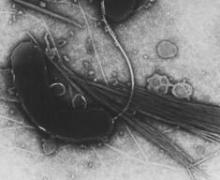Cholera ranks among the oldest and most durable of human diseases. Medical history says the world is in the midst of the seventh cholera pandemic since counting began in 1817, and the current pandemic has persisted since 1961. The take-away from those facts? Cholera has been around a long time, and isn’t going away anytime soon.
What keeps cholera at bay is a water supply that is kept separate from human sewage that could contain the Vibrio cholerae that transmits the infection, and treatment of the water supply by filtration and chlorination to further guarantee its cleanliness.
Those steps broke down in Haiti following the country’s devastating earthquake in January last year. By October 2010, a cholera epidemic began, had an initial spike last December (with a peak hospitalization rate of more than 2,500 people during the last week of December 2010), a second, smaller peak last June, and continuation through this month, with roughly 500 new hospitalized cases during the first week of October 2011, Dr. Scott F. Dowell from the Centers for Disease Control and Prevention reported earlier this week at the Infectious Diseases Society of America’s annual meeting in Boston.
All together, from October 2010 through this October, health authorities tallied 470,000 cholera cases and more than 6,200 associated deaths in Haiti.
Remarkably, this massive outbreak occurred following a CDC projection after the earthquake that cholera in Haiti was “unlikely,” because the disease was absent from the Caribbean, and had not been identified in Haiti for more than 100 years, Dr. Dowell said. While this meant that cholera had to come from somewhere else, it also meant that the local population was immunologically naive.
A molecular epidemiology study published last January found that the cholera strain causing the Haitian outbreak was not the strain that has been endemic in South America for several years, but most closely resembled a South Asian strain seen in Bangladesh in 2002 and 2008, and hence introduced into Haiti “through human activity.”
The earthquake-related wreckage of Haiti’s sanitation system and water supplies produced the fertile ground for a devastatingly large-scale cholera epidemic triggered by someone who brought the bacterium into the country, a turn of events that not even communicable-disease experts had anticipated.
---Mitchel Zoler (on Twitter @mitchelzoler)

